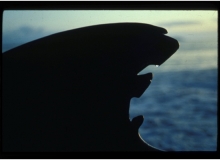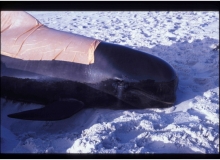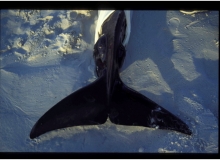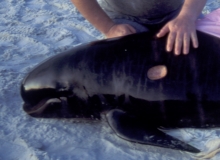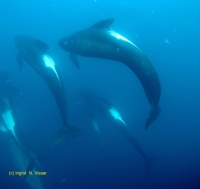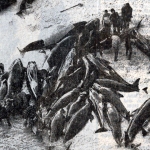
89- 90 pilot whales stranded on the remote northern beach of Parengarenga on the 27th of October 1992. When first found, at least 25 were dead, many packed so closely to each other that it was nearly impossible to separate them to facilitate rescue. After spending the night on the beach with the animals five were placed into Rescue Pontoons and used to ‘lure’ the remaining 50 animals out to sea.
During the initial rescue phase and overnight between 14–24 pilot whales were swept out into the channel in the strong incoming tidal rip. The ratio of whales to rescuers was overwhelming and it was unclear if the whales which were swept away were all alive or dead (or a combination of both). Because of the limited number of rescuers available, it was not possible to release the whales at the first high-tide, therefore they were kept overnight.
The smaller pilot whales were moved up higher onto the beach for their and the volunteer’s safety. They were kept wet and calm by concerned members of the public who had turned out to help. The larger animals presented the problem in that as the tide receded they tended to lean onto their sides, which could have resulted in their drowning as the incoming tide swept over their blowholes. The rescuers worked hard all night to keep the whales alive and their efforts were well rewarded as by morning no whale who had a volunteer with them had died.
On the high tide that day the 49-50 surviving whales were refloated and assembled in about waist- deep water, facing out to sea, all the while being gently rocked. This rocking and rolling allows the whales to regain their balance. It was important to not let individual whales leave, as they could potentially draw whales, who had not yet regained their balance, out to sea and thereby result in a restranding.
After all the whales had sufficient time to regain their balance, rescuers placed five of the whales into the Rescue Pontoons (designed by Steve Whitehouse) and secured them alongside boats. The boats then slowly took the whales, still inside the pontoons, out to the Parengarenga Harbour entrance. They were then turned towards the whales waiting patiently at the shore. The pilot whales in the pontoons were then used them to lure the other 45 whales out to the harbour entrance. Once these 45 were out past the heads, the five in the pontoons were released and all the whales formed a tight group which was very tactile with each other.
After the whales were refloated boats stayed with them for about two hours before a plane started monitoring them at about 1300 hrs (1 pm). The plane circled the group for about 30 minutes, then looked around the harbour for more whales but did not find any other stranded.
A yellow biodegradable tape had been put around the tails of most of the whales to identify them if they came ashore again.
After refloating them, four dead whales were found in Waikuku Beach, likely to be members of those, which had freed themselves with the high tide at midnight on the 27th /28th
Two days after the successful refloat a group of pilot whales was spotted heading towards North Cape, which was possibly the same rescued individuals.
Rescue Images
Quick Facts
| Name | Pilot whale, long-finned |
| Image |
|
| Suborder | Odontoceti |
| Family | Delphinidae |
| Max. size - Male | 6.7 m (21.9 ft) |
| Max. size - Female | 5.7 m (18.7 ft) |
| Calf size | 1.7-1.8 m (5.5-5.9 ft) |
| Max. weight - Male | 2,300 kg |
| Max. weight - Female | 1,300 kg |
| Calf weight | 75 kg |
| Food | primary food is squid, but known to take fish |
| Latin name | Globicephala melas |
| Location |
Parengarenga Harbour, Northland |
| Latitude |
-34.51983 |
| Longitude |
172.98080 |
| Number of Whales |
89-90 |
| Number rescued/saved |
49-50 |
At this rescue
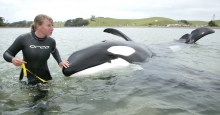
Ingrid has attended numerous mass and individual strandings. She is experienced in sampling and data collection at these events, and in the use of refloatation Rescue Pontoons and other rescue equipment. She has served on the Board and was a trainer for another stranding rescue group.
Read more ››
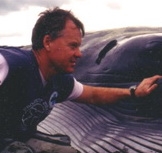
From a background as the NZ Whale Rescue Coordinator and a Fisheries Officer, Steve went on to design and implement both the Marine Mammal Medic (MMM) course, including full procedure manuals and the Whale Rescue Refloatation Pontoon System in the 1980s. Originally designed to train DoC staff and authorities in effective whale rescue techniques, Steve later redeveloped the MMM course for the layperson.
Read more ››
With special thanks to
To all those kind folks who ferried the rescuers across to help save the whales.
To all those who brought us all food and hot chocolate to keep us going over night.
In memorandum of Lewis Parkinson, who dreamed of saving whales and had his chance at Parengarenga.


